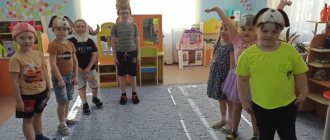Speech development in the middle group of preschool educational institutions
The development of communication and speech skills, which includes enriching vocabulary and developing clear pronunciation, is considered one of the main tasks for preschoolers.
Note! For the correct speech development of children in the middle group, educators do a tremendous amount of work. It is based on a set of special exercises and methodological techniques aimed at improving speech skills and developing a high culture and politeness of speech.
To develop speech in the middle group of preschool educational institutions, various directions are used:
- children’s knowledge and ideas about surrounding objects deepen;
- children become familiar with the details and names of parts of things;
- words denoting the properties of objects and phenomena are studied;
- vocabulary in the field of professions is replenished;
- words that denote relationships between people are studied;
- children learn to express their own thoughts in complex sentences that are grammatically correct.
To solve the assigned tasks in the middle group, the teacher must take a responsible approach to the process and purposefully conduct classes.
Federal State Educational Standards requirements for speech development
All educational institutions, regardless of whether they are public or private, must focus on certain program requirements that are specified in the Federal State Educational Standard.
As for the speech development of preschoolers, the requirements are as follows:
- Vocabulary must be constantly enriched;
- the child must have speech skills in accordance with age;
- the sound and intonation range of speech expressiveness should expand;
- develop the ability to perceive sounds by ear and at the same time hear, identify and, if there are errors, correct them;
- develop the ability to listen and remember the storyline;
- develop logically consistent and meaningful speech;
- skills of retelling and acting out dialogues;
- the child must learn to convey the meaning emotionally and read a poem by heart with expressiveness;
- work should be carried out to expand the horizons of preschoolers about objects, properties, phenomena and the concept of a coordinate system;
- generalizing concepts are introduced into the lexicon;
- training is provided to improve the grammatical construction of sentences.
Note! All training sessions should be conducted by the teacher so that they simultaneously include solving assigned problems and game moments. Only in this case will it be possible to interest children and achieve the desired results.
Age-related psychological characteristics of children in the middle group of preschool educational institutions
In terms of development, middle preschool age is a continuation of early childhood. During this period, children master the world of permanent things, master the culture of speech, and the formation and development of psychological perception also occurs.
In middle age, children continue to actively develop speech, substitution ability, thinking and imagination. With the help of speech, middle group students express their emotions and share their impressions.
Note! There is a rapid development of memorizing information and retaining it in memory, and the ability to concentrate is also enhanced.
As a rule, at this age, kindergarten teachers conduct special planned classes on speech development. They are provided for by special educational standards. But, despite this, pedagogical work in this direction is not limited to a certain framework. The most important thing is that when selecting tools, the teacher must take into account all the age characteristics of his students.
Methodological tools
Within the framework of the requirements of speech development, the teacher faces serious tasks that force him to approach the process thoughtfully, responsibly and in accordance with certain standards.
Basic pedagogical techniques
Each lesson on speech development in the middle group should be based on a specific pedagogical technique. Currently, three main groups of speech development techniques in preschool institutions have been identified. These are verbal, visual and playful techniques.
Their essence is as follows:
- Teaching stories using story pictures.
- Daily reading of fiction, which is provided for in the educational program.
- Carrying out work with children in a conversation format.
- Application of gaming technologies.
- Systematic and unobtrusive repetition of a new word.
- Motivation to complete the curriculum.
Note! In addition to implementing the pedagogical techniques listed above, the teacher must organize physical education sessions for students. They are also part of the curriculum and help to develop a serious attitude towards physical education in children.
Games for speech development
By the age of five, children should learn to pronounce all sounds correctly. You can achieve your goal through daily breathing exercises.
You can form grammatically correct speech thanks to games and exercises:
- "More less".
- “Call me kindly.”
- “Whose toy?”
- “Continue the sentence.”
- "Which".
Speech corner equipment
In order to stimulate independence and informal playful communication with children, in accordance with the requirements of the Federal State Educational Standard, an aesthetically attractive, comfortable and special subject-development environment must be created in which children will not be afraid, but rather feel at ease and at ease.
Important! It is best to place the speech corner away from the playing area in a well-lit place. It must be equipped with didactic and visual aids, as well as the necessary materials that are used by the teacher during classes.
Table: filling out the speech corner by section
| Chapter | Content |
| Certificate | Schemes of words, sentences and corresponding games (“Add a word”, “Choose a word”), puzzles and crosswords. |
| Connected speech | Subject pictures, “Playing in the profession”, “Guess by the description”. |
| Grammar | Games “Name it affectionately”, “One-many”. |
| Vocabulary | Pictures, lotto, puzzles. |
| Sound pronunciation | Game exercises, games to automate sounds. |
| Breath | Pipes, bubbles, balloons for inflation. |
| Fine motor skills | Pencils, puzzles, mosaics, tops. |
| Phonetic hearing | Sound differentiation games. |
| Articulation gymnastics | Pictures, sets of exercises, methodological literature. |
| Higher mental functions | Dominoes, cut pictures. |
Note! Among other things, experts recommend having Ushakova’s book “Speech Development” in the speech corner. It examines in detail all the problems of speech development for children in the middle group, selects methodological recommendations and compiles lesson notes.
Development of coherent and clear speech
- Correctly and clearly articulates the sounds of his native language. There may be some difficulties in pronouncing some complex sounds, such as hissing. Also, some children do not pronounce “l” and “r” clearly.
- Knowledge of singular and plural numbers. The ability to generalize objects into groups and voice their common name: dolls and cubes - toys, spoons and mugs - dishes, table and chair - furniture and so on.
- Compose competent sentences and small coherent texts.
- Make retellings, as well as descriptions of pictures and objects.
- Answer the teacher’s questions about the work you read.
- Know short children's poems by heart.
Lesson on speech development in the middle group
Planning lessons should be carried out according to methodological recommendations.
Lesson structure
Each lesson should be conducted according to a specific scheme:
- The organizational introductory part is characterized by a motivating and stimulating nature. The main task of the teacher at this stage is to get the children into the mood for work and awaken their interest in the topic.
- Practical part - the teacher sets the tasks and explains the essence of the task.
- Active work - children complete tasks in conjunction with a verbal assessment of the students’ activities.
- Summing up - the teacher’s goal is to draw children’s attention to the result.
Getting to know the world around you
- Knows the shapes, sizes and materials of objects.
- Knows the basic objects that surround him in everyday life: furniture, dishes, clothes, shoes, toys, food, plants, vehicles.
- Knows the body parts of humans and animals.
- Knows the locality where he lives.
- Possesses basic skills of traffic rules: pedestrian crossing, green and red traffic lights.
What can your child do?
By the age of 5, the baby already has skills, based on which you can judge the normal development of your child, as well as organize his future activities, educational games and activities.
Consider the general development indicators of older preschoolers.
Speech development
- Builds complex sentences and uses verbs in various tense forms.
- He is interested in the meaning of words, tries to explain the meaning of a word on his own, and can come up with it.
- Rhymes words. Sometimes he distorts a word to make it rhyme (for example, grandfather - handsome grandfather).
- Uses intonation.
- Teaches poems, even large ones.
Social and emotional development
- Partially knows how to control his emotions.
- Can manipulate adults through emotions. He understands that if he cries, they will give him candy. In this case, you should not indulge the child.
- Interested in feelings and emotions: “What is love? Why am I angry? Why is the girl screaming?
- Tries to independently cope with difficulties in communication (for example, if someone offended or took away a toy).
- Uses role-playing games and substitute toys.
- Gender identification becomes more pronounced: “I am a boy. Boys are strong and girls are beautiful!”
- In boys, the role of a protector is manifested (to fight, fight, protect mother), and in girls, the role of a mother is manifested (taking care of toys, playing mother-daughter).
Development of thinking and cognitive skills
- Can count to 10 or 20.
- Knows the names of some letters or shows interest in learning them, can even read syllables.
- State your first and last name, age and address.
- Knows the colors and different shapes of objects.
- Orients itself in space: back, forward, left, right, further, closer, higher, lower.
- Can use gadgets (make phone calls, play cartoons on TV/tablet).
- Becomes more independent in maintaining personal hygiene.
- Able to solve simple logical problems.
- Knows the names of surrounding objects.
- Copies or strives to copy the behavior of an adult of the same sex: “I fish like dad!”, “I paint my lips and comb my hair like mom!”.
Gaming and everyday skills
- Plays with the ball (catch, throw).
- Can jump over obstacles.
- Climbing the horizontal bar ladder.
- Makes the bed.
- Cuts with scissors.
- Strives to depict objects (house, person, sun, car).
- Shows interest in sports, dancing or music.
- Knows that crossing the road or playing on the road is dangerous.
Physical development
- The growth process is activated (in a year a child can grow by 10 cm). Boys' height is on average 106-116 cm, and their weight is from 16 to 20 kg. Girls' height is from 102 to 112 cm, weight is from 15 to 19 kg.
- Coordination of movements improves.
- Motor skills are actively developing, thanks to which the child can already perform more complex actions. It should be noted that the ossification process at this age is not yet complete, so bones easily break when falling.




